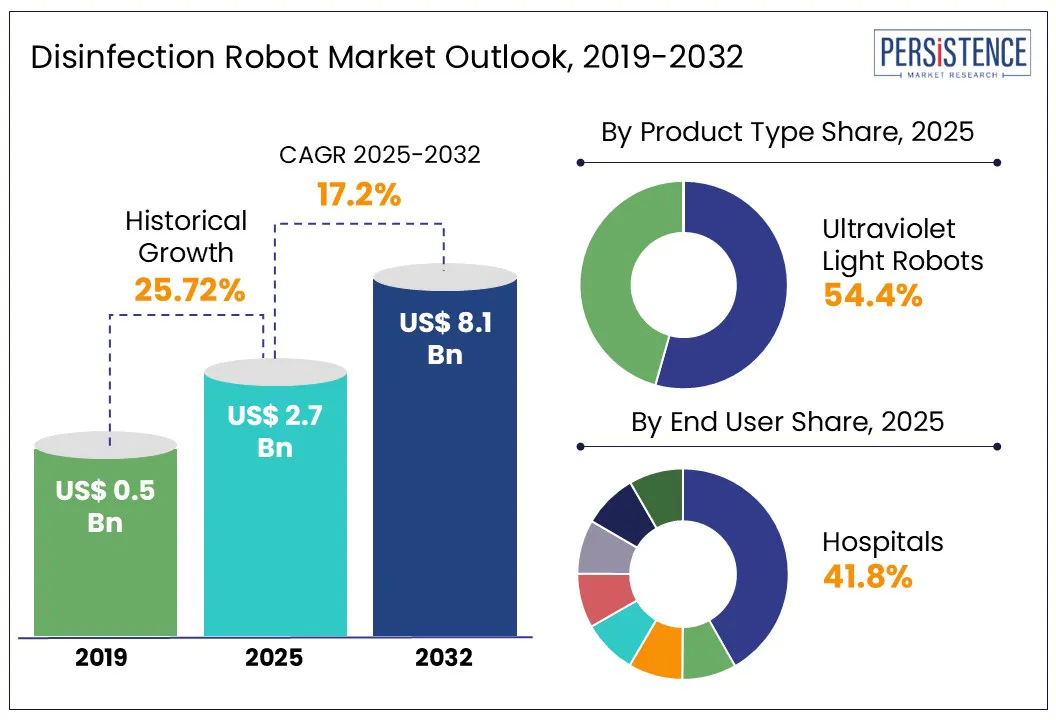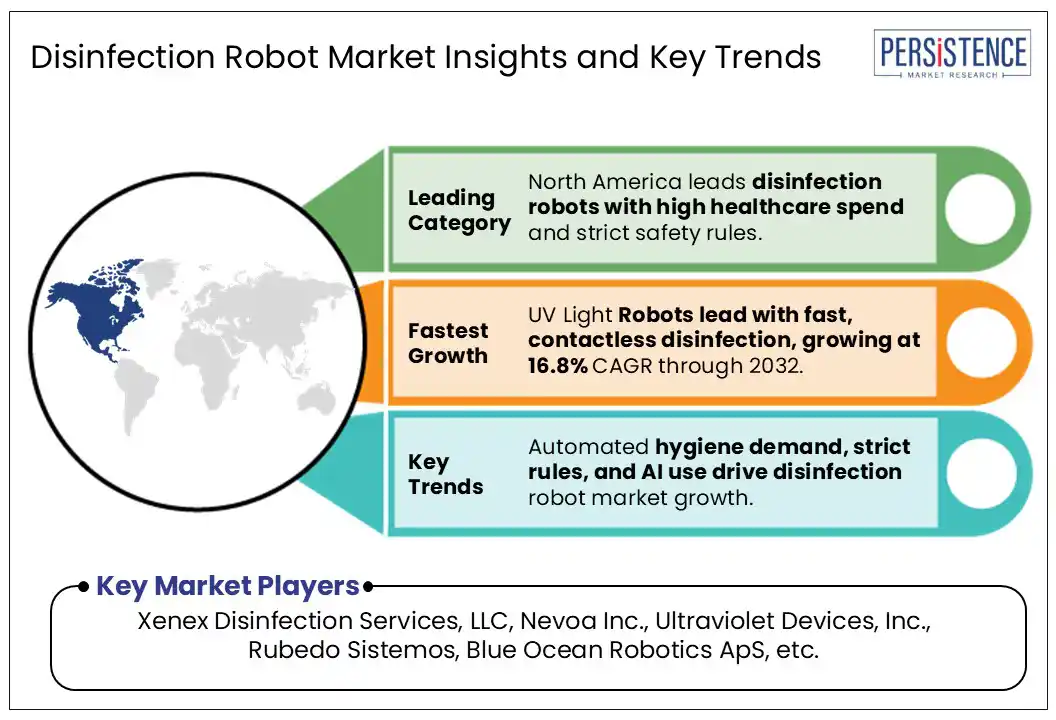ID: PMRREP22822| 195 Pages | 20 Jun 2025 | Format: PDF, Excel, PPT* | Healthcare

The global disinfection robot market size is likely to be valued at US$2.7 billion in 2025 and is estimated to reach US$8.1 billion by 2032, growing at a CAGR of 17.2% in the forecast period from 2025 to 2032.
The demand for advanced disinfection robots has increased as a result of the rise in danger of HAI (hospital-acquired infections) transmission. Post-pandemic the disinfectant manufacturing companies have surged in sales as a result of the novel coronavirus outbreak. Adoption of improved, well-designed portable robots has opened new, lucrative market potential for manufacturers. To create technologically advanced and personalized disinfection robots, manufacturers will be drawn to supply needs and specifications as healthcare infrastructure investment rises.
Mobile robots with UV sanitizing features are currently a popular trend in the industry. Due to the growing need for service robots, notably in the healthcare sector, the market will grow. Sanitation and disinfection are a growing concern, particularly in densely crowded areas such as hospitals, hotels, airports, and institutions. Because of this, more organizations and companies are investing in robots and switching to automation for disinfection applications.

Key Industry Highlights
|
Global Market Attribute |
Key Insights |
|
Disinfection Robot Market Size (2025E) |
US$ 2.7 Bn |
|
Market Value Forecast (2032F) |
US$ 8.1 Bn |
|
Projected Growth (CAGR 2025 to 2032) |
17.2% |
|
Historical Market Growth (CAGR 2019 to 2024) |
25.7% |
Hospitals require disinfection treatment periodically to prevent the spread of infection and contamination. outbreak of COVID-19 has given manufacturers a better opportunity to set their company apart from rivals, and as a result, the market is providing a wide range of products.
The disinfection robot market offers a wide variety of products, from UVC disinfection technology to hydrogen peroxide vapor, from semi-autonomous to fully autonomous robotic systems. To satisfy end-user demand, the market provides a wide range of products. For instance, Xenen offers a proprietary pulsed xenon UV system, Ultraviolet Devices, Inc. offers UVC technology, and The Clorox Company offers UV mercury disinfection robots.
Numerous hospitals and healthcare facilities already use cleaning and disinfection solutions and products to keep their surroundings clean; as a result, they are reluctant to integrate disinfection robots into their infrastructure. The market expansion for disinfection robots is hampered by the introduction of numerous disinfectant products following the epidemic. The deployment of these robots for cleaning and disinfection purposes is further constrained by the scarcity of skilled professionals who can operate disinfection robots, especially in growing economies.
The rising demand for efficient and automated infection control solutions presents a significant opportunity for the disinfection robot market. Expanding healthcare infrastructure globally, especially in emerging economies, creates a growing need for advanced disinfection technologies. Increased awareness of healthcare-associated infections (HAIs) and stringent regulatory standards drive adoption across hospitals, clinics, and public spaces. Additionally, technological innovations such as AI integration and multi-functional robots broaden application areas beyond healthcare, including hospitality, transportation, and education sectors. The COVID-19 pandemic has also heightened focus on contactless sanitation, accelerating market acceptance. These factors combine vast potential for market expansion and innovation in the disinfection robot industry.
The ultraviolet light robots segment holds a 54.5% share in 2024 within the product segment. As UV technology effectively eliminates viruses, bacteria, and other pathogens, it is becoming more and more popular for disinfection services. This technique is time and money-efficient because it lessens the load of human cleaning. In recent years, the market has seen a sharp increase in demand for UV light robots from healthcare facilities, mostly as a result of increasing demand for sanitizing treatments following the pandemic.
Additionally, their adoption is expanding into other sectors such as hospitality, transportation, and commercial buildings, where rapid and thorough disinfection is critical. Continuous advancements in UV-C technology are enhancing robot efficiency, safety, and ease of use, further boosting market growth.
Hospitals account for a prominent position in the disinfection robot market in the forecast period. Hospitals are highly susceptible to viruses and infections due to frequent contact with sick patients, many of whom carry contagious diseases. This increases the risk of healthcare-associated infections (HAIs), which can lead to higher patient complications and increased healthcare costs. To address this, many healthcare facilities are adopting disinfection robots that provide continuous and automated surface cleaning. Using technologies such as ultraviolet (UV) light, these robots effectively eliminate pathogens from surfaces, including hard-to-reach areas. Compared to manual cleaning, robotic disinfection offers greater consistency and reduces human error, helping hospitals prevent HAIs and improve patient safety.

The U.S. is projected to hold approximately 34.1% of the global disinfection robot market share by the end of 2024, underscoring North America's dominant position in this sector. The demand for disinfection robots surged significantly following the COVID-19 pandemic, as healthcare facilities and public spaces sought effective, automated cleaning solutions to curb infection risks. This increased adoption is driven by heightened awareness of hygiene and safety protocols across hospitals, businesses, airlines, and transportation hubs such as train stations. Robotic disinfection systems offer efficient, contactless cleaning, reducing reliance on manual labor and minimizing cross-contamination.
Moving forward, these systems are expected to maintain strong demand throughout the forecast period as organizations continue prioritizing infection control and cleanliness. Innovations in UV-C technology and AI integration further support market growth, making North America a key region for advancing disinfection robot adoption in healthcare and public sectors.
The European disinfection robot market is experiencing notable growth, driven primarily by increasing awareness among medical professionals about the advantages of robotic disinfection over traditional manual methods. Disinfection robots offer enhanced efficiency, consistency, and reduced risk of human error, making them highly attractive in healthcare settings. Additionally, the expansion of medical infrastructure across Europe, including hospitals, clinics, surgical centers, and research laboratories, is fueling demand for automated disinfection solutions to maintain high hygiene standards. The COVID-19 pandemic further accelerated adoption by highlighting the need for effective, contactless sanitation methods. Technological advancements in ultraviolet (UV) and AI-powered robots are also boosting market growth by improving the accuracy and speed of disinfection processes.
Furthermore, government initiatives and stringent regulatory frameworks promoting infection control are encouraging healthcare providers to invest in these innovative technologies. Overall, these factors combine to create a robust and expanding market for disinfection robots across Europe.
Asia Pacific disinfection robot market is witnessing significant growth, driven by the increasing prevalence of hospital-acquired infections (HAIs) in the region. HAIs pose a major challenge to healthcare systems, affecting many patients annually and leading to increased mortality rates. These infections also extend hospital stays, resulting in higher medical costs for patients. As a result, there is a growing demand for disinfection robots in hospitals to enhance infection control and reduce HAIs effectively.
Additionally, expanding healthcare infrastructure, including hospitals, clinics, and research centers, is further propelling market growth. Rising awareness among healthcare professionals about the benefits of automated disinfection, combined with government initiatives to improve patient safety, is accelerating the adoption of advanced robotic disinfection solutions across Asia Pacific, making it a key growth region in the global market.
Manufacturers are concentrating on diversifying their product lines by introducing new, advanced products and securing approval from various governmental agencies. Leading providers of immunoassay blockers are actively engaged in strategic product development and expansion through partnerships to increase their market position.
The global market size is likely to be valued at US$ 2.7 billion in 2025
Rising HAIs, stringent hygiene regulations, AI and UV-C advancements, and demand for autonomous cleaning solutions propel market growth.
The market is projected to record a CAGR of 17.2% during the forecast period from 2025 to 2032.
BioLifeSolutions, Inc., CARON Products & Services, Inc., Farrar Scientific, GE Healthcare Life Sciences, HOF Sonderanlagenbau GmbH, and Others.
Expanding healthcare infrastructure, rising demand in public spaces, and technological advancements present significant growth opportunities for disinfection robot adoption.
|
Report Attribute |
Details |
|
Historical Data/Actuals |
2019 - 2024 |
|
Forecast Period |
2025 - 2032 |
|
Market Analysis Units |
Value: US$ Bn, Volume: As applicable |
|
Geographical Coverage |
|
|
Segmental Coverage |
|
|
Competitive Analysis |
|
|
Report Highlights |
|
|
Customization and Pricing |
Available upon request |
By Product Type
By Technology
By End-user
By Region
Delivery Timelines
For more information on this report and its delivery timelines please get in touch with our sales team.
About Author